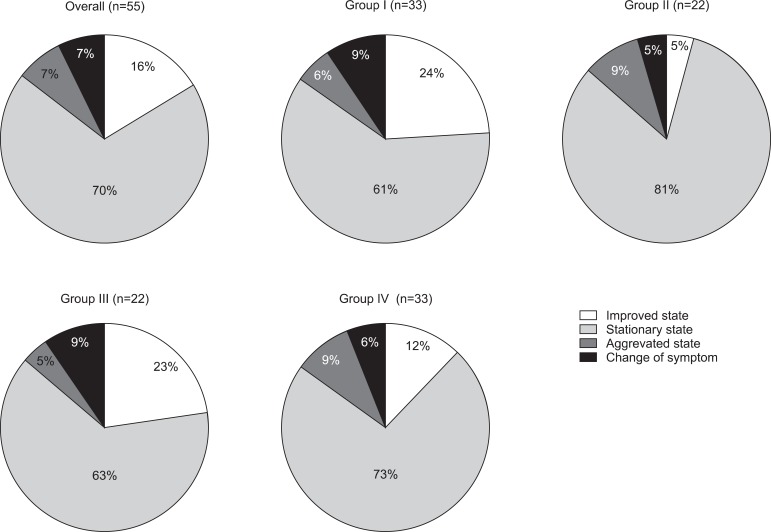J Korean Assoc Oral Maxillofac Surg.
2013 Jun;39(3):127-133. 10.5125/jkaoms.2013.39.3.127.
Clinical outcome of conservative treatment of injured inferior alveolar nerve during dental implant placement
- Affiliations
-
- 1Department of Oral and Maxillofacial Surgery, School of Dentistry and Dental Research Institute, Seoul National University, Seoul, Korea. leejongh@snu.ac.kr
- 2Division of Oral and Maxillofacial Surgery, Department of Dentistry, Oral and Maxillofacial Surgery, Ajou University School of Medicine, Suwon, Korea.
- 3Department of Occupation and Environment, Konkuk Univiersity School of Medicine, Chungju, Korea.
- KMID: 1430480
- DOI: http://doi.org/10.5125/jkaoms.2013.39.3.127
Abstract
OBJECTIVES
Infererior alveolar nerve (IAN) damage may be one of the distressing complications occurring during implant placement. Because of nature of closed injury, a large proportion is approached non-invasively. The purpose of this study was to analyze the outcomes of conservative management of the injured nerve during dental implant procedure.
MATERIALS AND METHODS
Sixty-four patients of implant related IAN injury, who were managed by medication or observation from January 1997 to March 2007 at the Department of Oral and Maxillofacial Surgery, Seoul National University Dental Hospital, were retrospectively investigated. The objective tests and subjective evaluations were performed to evaluate the degree of damage and duration of sensory disturbance recovery. Tests were performed on the day of the first visit and every two months afterward. Patient's initial symptoms, proximity of the implant to the IAN, time interval between implant surgery and the first visit to our clinic, and treatment after implant surgery were analyzed to determine whether these factors affected the final outcomes.
RESULTS
Among the 64 patients, 23 had a chief complaint of sensory disturbance and others with dysesthesia. The mean time until first visit to our hospital after the injury was 10.9 months.One year after nerve injury, the sensation was improved in 9 patients, whereas not improved in 38 patients, even 4 patients experienced deterioration. Better prognosis was observed in the group of patients with early visits and with implants placed or managed not too close to the IAN.
CONCLUSION
Nearly 70% of patients with IAN injury during implant placement showed no improvement in sensation or dysesthesia with the conservative management. Earlier decision for active treatment needs to be considered because of possibility of deterioration of symptoms and unsatisfactory recovery.
Keyword
MeSH Terms
Figure
Reference
-
1. Kiyak HA, Beach BH, Worthington P, Taylor T, Bolender C, Evans J. Psychological impact of osseointegrated dental implants. Int J Oral Maxillofac Implants. 1990; 5:61–69. PMID: 2202671.2. Bartling R, Freeman K, Kraut RA. The incidence of altered sensation of the mental nerve after mandibular implant placement. J Oral Maxillofac Surg. 1999; 57:1408–1412. PMID: 10596660.
Article3. Ellies LG, Hawker PB. The prevalence of altered sensation associated with implant surgery. Int J Oral Maxillofac Implants. 1993; 8:674–679. PMID: 8181830.4. Vazquez L, Saulacic N, Belser U, Bernard JP. Efficacy of panoramic radiographs in the preoperative planning of posterior mandibular implants: a prospective clinical study of 1527 consecutively treated patients. Clin Oral Implants Res. 2008; 19:81–85. PMID: 17956572.
Article5. Htut M, Misra P, Anand P, Birch R, Carlstedt T. Pain phenomena and sensory recovery following brachial plexus avulsion injury and surgical repairs. J Hand Surg Br. 2006; 31:596–605. PMID: 16822598.
Article6. Pogrel MA. The results of microneurosurgery of the inferior alveolar and lingual nerve. J Oral Maxillofac Surg. 2002; 60:485–489. PMID: 11988920.
Article7. Frei C, Buser D, Dula K. Study on the necessity for cross-section imaging of the posterior mandible for treatment planning of standard cases in implant dentistry. Clin Oral Implants Res. 2004; 15:490–497. PMID: 15248885.
Article8. Strauss ER, Ziccardi VB, Janal MN. Outcome assessment of inferior alveolar nerve microsurgery: a retrospective review. J Oral Maxillofac Surg. 2006; 64:1767–1770. PMID: 17113443.
Article9. Renzi G, Carboni A, Perugini M, Giovannetti F, Becelli R. Posttraumatic trigeminal nerve impairment: a prospective analysis of recovery patterns in a series of 103 consecutive facial fractures. J Oral Maxillofac Surg. 2004; 62:1341–1346. PMID: 15510354.
Article10. Wismeijer D, van Waas MA, Vermeeren JI, Kalk W. Patients' perception of sensory disturbances of the mental nerve before and after implant surgery: a prospective study of 110 patients. Br J Oral Maxillofac Surg. 1997; 35:254–259. PMID: 9291263.
Article11. Hillerup S. Iatrogenic injury to oral branches of the trigeminal nerve: records of 449 cases. Clin Oral Investig. 2007; 11:133–142.
Article12. Seo K, Tanaka Y, Terumitsu M, Someya G. Characterization of different paresthesias following orthognathic surgery of the mandible. J Oral Maxillofac Surg. 2005; 63:298–303. PMID: 15742277.
Article
- Full Text Links
- Actions
-
Cited
- CITED
-
- Close
- Share
- Similar articles
-
- Surgical Removal of Dental Implants Dislocated Into the Mandibular Body
- Implant Rehabilitation in the Unfavorable Alveolar Ridge
- Implant placement with inferior alveolar nerve repositioning in the posterior mandible
- Diplopia after Inferior Alveolar Nerve Block Anesthesia: A Case Report
- Updates on the Inferior Alveolar Nerve Block Anesthesia


